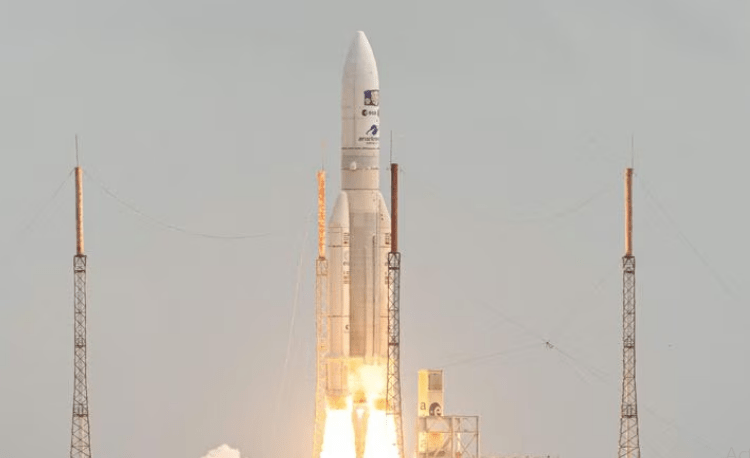ESA’s Jupiter Icy Moons Explorer (Juice) lifted off on an Ariane 5 rocket from Europe’s Spaceport in French Guiana at 14:14 CEST on 14 April. The successful launch marks the beginning of an ambitious voyage to uncover the secrets of the ocean worlds around giant planet Jupiter.
Following launch and separation from the rocket, ESA’s European Space Operations Centre (ESOC) in Darmstadt, Germany, confirmed acquisition of signal via the New Norcia ground station in Australia at 15:04 CEST. The spacecraft’s vast 27 m long solar arrays unfurled into their distinctive cross shapes at 15:33 CEST, ensuring Juice can travel to the outer Solar System. The completion of this critical operation marked the launch a success.
“ESA, with its international partners, is on its way to Jupiter,” says ESA Director General Josef Aschbacher. “Juice’s spectacular launch carries with it the vision and ambition of those who conceived the mission decades ago, the skill and passion of everyone who has built this incredible machine, the drive of our flight operations team, and the curiosity of the global science community. Together, we will keep pushing the boundaries of science and exploration in order to answer humankind’s biggest questions.”
“It is thanks to the leadership of ESA and the effort and commitment of hundreds of European industries and scientific institutions that the Juice mission has become a reality,” says Giuseppe Sarri, ESA’ s Juice Project Manager. “Together with our partners NASA, the Japan Aerospace Exploration Agency and the Israel Space Agency, who have also contributed hardware or scientific instrumentation, we have reached this much-awaited launch milestone.”
From Galileo to Juice
Jupiter, shining brightly in the night sky, has sparked fascination ever since our ancient ancestors first looked up. Astronomer Galileo Galilei brought Jupiter into focus in 1610, observing the planet through a telescope for the first time and discovering its orbiting moons. His observations overturned the long-held idea that everything in the heavens revolved around Earth. Centuries later, Juice – which carries a commemorative plaque in honour of Galileo’s discoveries – will see Jupiter and its moons in a way that Galileo couldn’t even have dreamt of.
Thanks to the legacy of previous Jupiter missions we know that three of the planet’s largest moons – Europa, Ganymede and Callisto – hold quantities of water buried under their surfaces in volumes far greater than in Earth’s oceans. These planet-sized moons offer us tantalising hints that conditions for life could exist other than here on our ‘pale blue dot’, and Juice is equipped to bring us one step closer to answering this alluring question.
“Over 400 years ago, Galileo discovered moons orbiting Jupiter – news that shocked the renaissance world and revolutionised humankind’s understanding of our place in the Universe,” says Carole Mundell, ESA’s Director of Science. “Today, we have sent a suite of ground-breaking science instruments on a journey to those moons that will give us an exquisite close-up view that would have been unimaginable to previous generations. Juice carries the dreams of anyone who’s ever gazed up at Jupiter shining brightly in the night sky and wondered about our origins.
“The treasure trove of data that ESA Juice will provide will enable the science community worldwide to dig in and uncover the mysteries of the jovian system, explore the nature and habitability of oceans on other worlds and answer questions yet unasked by future generations of scientists.”
Journey to Jupiter
Juice is the last ESA space science mission to launch on an Ariane 5, in a long legacy dating back to 1999 with the launch of XMM-Newton, which is still in operation today, and most recently, the NASA/ESA/CSA James Webb Space Telescope in 2021.
“What a magnificent demonstration of Europe’s capacity to dream big and deliver results to match,” says Daniel Neuenschwander, ESA’s Director of Space Transportation. “We can all be proud of Ariane 5 for making possible missions like Juice and setting such a high standard for our new generation of launch systems.”
Over the next two-and-half weeks Juice will deploy its various antennas and instrument booms, including the 16 m long radar antenna, 10.6 m long magnetometer boom, and various other instruments that will study the environment of Jupiter and the subsurface of the icy moons.
An eight-year cruise with four gravity-assist flybys at Earth and Venus will slingshot the spacecraft towards the outer Solar System. The first flyby in April 2024 will mark a space exploration first: Juice will perform a lunar-Earth gravity-assist – a flyby of the Moon followed 1.5 days later by one of Earth.
ESA’s spacecraft operators, technology engineers and mission analysts have worked exhaustively to prepare for the challenges that lie ahead on this adventurous mission.
Shields will protect the spacecraft’s sensitive electronics from the monstrous levels of radiation in the Jupiter system. Multi-layered insulation will keep internal temperatures stable while externally they may reach more than 250ºC during the Venus flyby and -230ºC at Jupiter.
“Hundreds of millions of kilometres from Earth and powered by just a sliver of sunlight, we will guide Juice through 35 flybys of Jupiter’s ocean moons in order to gather the data needed to bring scientists closer than ever to these compelling destinations,” says Ignacio Tanco, ESA’s Juice spacecraft operations manager.
By The European Space Agency (ESA)
Continue reading this article here on the website of ESA: https://www.esa.int/Science_Exploration/Space_Science/Juice/ESA_s_Juice_lifts_off_on_quest_to_discover_secrets_of_Jupiter_s_icy_moons

